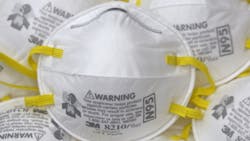OSHA Provides Guidance on Respirator Reuse and Decontamination
OSHA has now defined the proper methods to sanitize filtering facepiece respirators such as N95s for reuse following decontamination.
Patrick Kapust, acting director of the Directorate of Enforcement Programs, released the temporary guidance directed at healthcare employers on Friday, April 24.
He writes, "Although the Secretary, through OSHA, has allowed for enforcement flexibility around respirators—including with regard to fit-testing, the use of respirators that are beyond their manufacturer's recommended shelf life, extended use and reuse of respirators, and the use of alternative equipment certified by the National Institute for Occupational Safety and Health (NIOSH) or in accordance with standards of certain other countries and jurisdictions—the availability of FFRs remains a concern throughout the country."
The widespread scarcity of filtering facepiece respirators (FFRs) has resulted in the reuse of the disposable equipment in healthcare settings across the country.
President Donald Trump addressed the shortage in a March 11 memo, saying: "To help prevent the spread of COVID-19, the Secretary of Health and Human Services shall take all appropriate and necessary steps with respect to general use respirators to facilitate their emergency use by healthcare personnel in healthcare facilities and elsewhere, including under the authorities granted by section 319F-3 of the Public Health Service Act (42 U.S.C. 247d-6d) and section 564 of the Federal Food, Drug, and Cosmetic Act (21 U.S.C. 360bbb-3). Additionally, the Secretary of Labor shall consider all appropriate and necessary steps to increase the availability of respirators."
The interim guidance specifically targets settings in which workers need respirators such as those in healthcare where there is direct respiratory exposure with individuals who are suspected of having or have been confirmed to have SARS-CoV-2, the virus that causes COVID-19.
The memo states that if respiratory protection must be used and no "acceptable" alternatives are available, the following methods may be used for decontamination FFRs: vaporous hydrogen peroxide; ultraviolet germicidal irradiation; and/or moist heat (i.e., using an oven). Microwave-generated steam or liquid hydrogen peroxide also are "suitable" if no other methods can be utilized.
Objective data surrounding the following methods are not available and therefore are not considered adequate for decontamination: autoclaving, dry heat, isopropyl alcohol, soap, dry microwave irradiation, chlorine bleach; disinfectant wipes, regardless of impregnation (i.e., chemical saturation); and/or ethylene oxide.
"Employers should investigate the effectiveness of any particular decontamination method used for the specific filtering facepiece respirator model to be decontaminated," the memo states. "Employers should be able to demonstrate the effectiveness of any decontamination method used against the likely contaminant(s) (i.e., pathogens) of concern, and that the decontamination method used does not produce additional safety hazards."
The agency will continue to address different decontamination methods and provide further interim guidance as needed.
For now, employers must follow their respiratory protection programs (RPPs) which are required under OSHA's respiratory standard as well as monitor the ongoing shortages of personal protective equipment (PPE).
OSHA also provided enforcement guidance, saying all employers should:
- Make a good-faith effort to provide and ensure workers use the most appropriate respiratory protection available for the hazards against which workers need to be protected. Efforts should be consistent with flexibilities outlined in the agency's previous COVID-19 enforcement memoranda.
- When respirators must be decontaminated to facilitate their reuse in ways consistent with OSHA's previous COVID-19 enforcement memoranda and the U.S. Centers for Disease Control and Prevention (CDC) Strategies for Optimizing the Supply of N95 Respirators, ensure that decontamination is accomplished according to the methods described above and detailed in CDC's Decontamination and Reuse of Filtering Facepiece Respirators using Contingency and Crisis Capacity Strategies.
- Ensure users perform a user seal check each time they don a respirator. Employers should not permit use of a respirator on which the user cannot perform a successful user seal check.
- Train employees to follow appropriate precautionary measures prior to using a decontaminated filtering facepiece respirator (FFR).
- Train employees using decontaminated respirators to understand that if the structural and functional integrity of any part of the respirator is compromised, it should not be used by that individual as respiratory protection. The inability to achieve a successful user seal check could be an indicator that the integrity of the respirator is compromised.
- Visually inspect, or ensure that workers visually inspect, the FFRs to determine if the structural and functional integrity of the respirator has been compromised. Over time or as a result of the decontamination process, components such as the straps, nose bridge, and nose foam material may degrade, which can affect the quality of the fit and seal.
- Train employees on the procedures for the sequence of donning/doffing to prevent self-contamination.
- If no manufacturer or third-party guidance or procedures are available to support the specific decontamination method(s) employed, avoid the use of decontaminated FFRs when healthcare personnel perform surgical procedures on patients infected with, or potentially infected with, SARS-CoV-2 or perform or are present for procedures expected to generate aerosols or procedures where respiratory secretions are likely to be poorly controlled (e.g., cardiopulmonary resuscitation, intubation, extubation, bronchoscopy, nebulizer therapy, sputum induction). If decontamination methods degrade FFR performance, including filtration and fit, or otherwise affect structural integrity, the decontaminated FFR may not provide the level of protection needed or expected during aerosol-generating procedures.
Enforcement discretion will be on a case-by-case basis. OSHA addressed its inspectors, saying: "If an employer fails to comply with fit testing, maintenance, care, and training requirements, cite the applicable provision(s) of 29 CFR § 1910.134 as serious violations."
About the Author

Stefanie Valentic
Stefanie Valentic was formerly managing editor of EHS Today, and is currently editorial director of Waste360.
